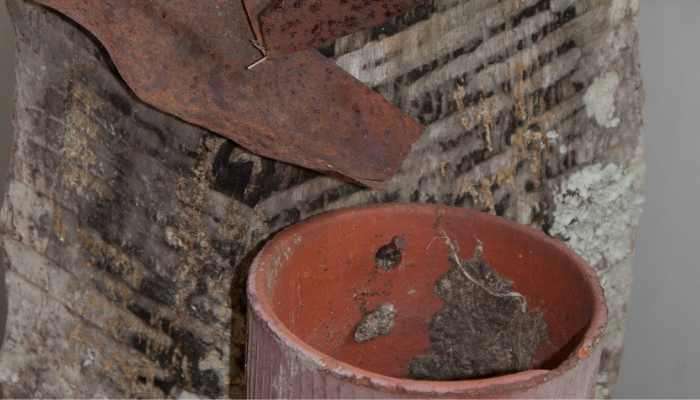Turpentine is an ancient solvent which also used by Old masters to create valuable paintings. Turpentine is a widely used medium for oil painting. Beyond skills, knowledge of mediums is necessary for an artist to achieve success in oil painting. One of the most widely used solvents is turpentine which is obtained by distillation of a resin obtained from pine trees.
But, why do you need turpentine for oil painting? Is it compulsory to use turpentine in oil painting? and in what ways turpentine can be used for oil painting?
Turpentine is used for multiple purposes: as a solvent, it can thin your oil paint, provide protection film from UV rays, Increase the drying time, clean oil paint out of brushes, clothes, carpet, and various stuff, protect your pigment from fading and prevent cracking of your oil paint.
Table of Contents
- One-Thin down oil paints
- Two-UV protection
- Three-Increasing drying time oil paints
- Four-Cleaning oil paint
- Five-Protecting oil paint from fading
- Six-Prevent cracking of oil paints after drying
- Is turpentine necessary for oil painting?
- The safest way to use turpentine for oil painting
- How to use turpentine for oil painting
- Linseed oil vs Tupentine
- What can I use instead of turpentine?
- When to use turpentine for oil painting?
- Final Words
Using turpentine can give you the whole control of your oil paints. Let’s discuss the magical purpose of turpentine in more detail.
One-Thin down oil paints
Today, there are so many forms of turpentine on market. It is important to distinguish between them because some are just made for cleaning purposes and some are made for thinning purposes.
Gum turpentine plays an important role in thinning down oil paint. It is highly preferred for thinning due to its dilute properties. As gum turpentine is expensive, it is recommended to avoid using it for cleaning purposes.
Two-UV protection
The turpentine layer acts as a sunglass for oil paints to protect from hazardous UV rays. UV rays cause the oil paint to become dull and lose its sheen. Turpentine layer work to block these UV rays and allow only sunlight to reach the oil paints.
Three-Increasing drying time oil paints
Turpentine is different from linseed oil because linseed oil is a drying oil but turpentine is a solvent. In drying, both work in the opposite way. If you want to increase the drying time of oil paints, use linseed oil but for decreasing drying time, use turpentine.
Turpentine has a lower consistency which evaporates faster than water. Adding turpentine with oil paint also fastens the drying time.
Four-Cleaning oil paint
Distilled turpentine is widely used as a cleaner for oil paint. To remove oil paint from any stuff including brushes, clothes, carpets, etc. distilled turpentine is an ideal solvent.
It acts as a cleaning agent like water but water cannot clean oil paint, but, turpentine does this work perfectly. But don’t use distilled turpentine to thin down your oil paints. Instead, use gum turpentine for thinning purposes.
Five-Protecting oil paint from fading
Turpentine is a shine enhancer that can restore old oil paintings to look glossy again. That is why you need turpentine for your oil paintings. The addition of gum turpentine not just thins down the oil paint but also prolongs the paint’s life.
Six-Prevent cracking of oil paints after drying
Using a large amount of linseed oil can cause cracks after drying but when the same work is given to turpentine, it prevents your oil paint from getting brittle and cracking.
Is turpentine necessary for oil painting?
There are various solvents available in the market which work the same as turpentine but turpentine is the most dominant. Even though, turpentine could be toxic to your health because of the toxic fumes it emits while using it.

If you want to create monumental artworks which could bring popularity among lovers of oil paint, turpentine is necessary. But as a beginner, you can use other solvents also which can help you to understand the working of solvents. Turpentine is recommended for professional use only.
Today, we have a facemask that can allow us to work protectively with turpentine. So, start today, and understand the working of turpentine in a protective way. Believe me, its results are just magical.
The safest way to use turpentine for oil painting
Turpentine is toxic due to the presence of Volatile Organic Compounds and the Occupational Safety and Health Administration (OSHA) has also classified it as a hazardous material. Turpentine has been extracted from pine trees which produce a resin called terpene. But most terpene resins could be safe for health but these resins then undergo various chemical processes which make them toxic.
The safest way is to use turpentine in a well-ventilated area by wearing face masks and hand gloves. There will be no safety concerns when you give attention to wearing at least a face mask and opening the window of your studio.
How to use turpentine for oil painting
Turpentine is super thin compared to linseed oil. Take out your face mask and hand gloves, let’s discuss the step-by-step method to use turpentine. But before starting, make sure to collect all the required materials.

Things to need:
- Turpentine
- Gum Turpentine for thinning purpose
- Distilled turpentine for cleaning purposes
- A brush
- A cup
Procedure:
- STEP 1: Pour a little amount of turpentine into a cup
- STEP 2: Take a brush and dip its bristle inside turpentine
- STEP 3: Mix the turpentine with oil paint by using a brush
- STEP 4: Check the consistency of the oil paint; add more to get the desired consistency
- STEP 5: To clean your brush, shake the bristle very well inside the turpentine until all the oil paint separates from the bristle. Use a paper towel to clean the bristle.
Linseed oil vs Tupentine
| Linseed oil | Turpentine | |
| Thinning Power | Low | High |
| Toxicity | Not toxic | Highly toxic when inhaled |
| Cleaning Power | Low | High |
| Price comparison | 22.29$ (250ml) | 15.89$ (250ml) |
| Drying time | Slower | Faster |
| Glazing Power | Less | High |
| Fluidity | Increase fluidity | Increase fluidity and reduce dropouts |
| Restoration Power | Less | High |
Linseed oil and turpentine are used for the same purposes but linseed oil is often used as a binder in oil paint that increases the fluidity when mixed with oil paints. As oil paints are made by mixing linseed oil and pigment, it is natural to add linseed oil to make them glossy and smooth.
On the other hand, turpentine is a solvent that acts as a thinner for oil paints. Its properties play an essential role in making the paint thinner and when it is used in larger quantities, it can just remove oil paint from any surface. That’s why it is also used as a cleaning agent to clean oil paint brushes.
What can I use instead of turpentine?
It totally depends on the way you want to use it. If you want to use it as a solvent, then you can use odorless mineral spirits and citrus-based solvents instead of turpentine. But if you want to use it as a medium then you can use linseed oil, safflower oil, stand oil, and walnut oil instead of turpentine.
In oil painting, every solvent and medium has its unique properties and we cannot find a unique property of one solvent in other. Maybe other solvents work better but in some ways, they will not provide you with the benefits of other.
By considering all the properties, linseed oil is the most preferred and highly useable substitute for turpentine which can be used for thinning, cleaning, and even glazing. The majority of artists prefer linseed oil over turpentine due to its toxicity. But if they use a face mask and hand gloves while working with turpentine, then they don’t have to think of using any substitute for turpentine.
When to use turpentine for oil painting?
You can use turpentine when you have to thin down oil paints, clean oil paint from stuff, create glazing effects or remove the old varnish.
As turpentine is toxic, so I recommend using it in a ventilated area where you cannot inhale poisonous fumes of turpentine. Wearing a face mask and hand gloves is also appreciated.
Final Words
Turpentine is a highly beneficial solvent for oil painting but not for your health. It is popular with thin oil paints and cleaning brushes. Its other uses include removing old varnish, creating glazing effects, and many more. It is also important to be careful when handling turpentine because it can be toxic. There are various alternatives to turpentine such as linseed oil, stand oil, safflower oil, etc. But the choice of using turpentine depends on the artists. A true artist can create a masterpiece with any medium or solvent just by using his knowledge and skills.
Read Also:
